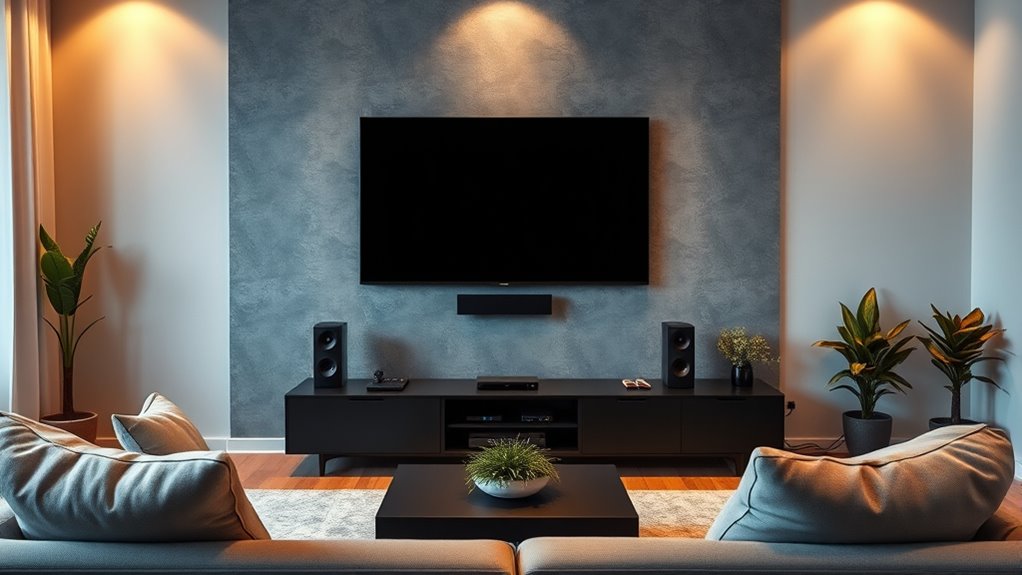To establish a caption‑friendly home entertainment system, start by enabling caption and audio description features on your devices through their accessibility menus. Use remote controls with clearly labeled, tactile buttons or voice control for easier operation. Confirm your smart TV or streaming device supports captioning, and customize the settings to your preferences. Properly configured equipment ensures a seamless, inclusive viewing experience—keep exploring to learn how to perfect your setup further.
Key Takeaways
- Enable closed captioning and subtitles in your TV or streaming device settings for all content.
- Activate and customize caption appearance, size, and language options for optimal readability.
- Ensure your remote control has accessible buttons for easy caption toggling and adjustment.
- Connect compatible devices that support caption features and verify their settings during setup.
- Involve users with hearing impairments to personalize caption preferences and test for clarity and comfort.

Creating a caption-friendly home entertainment system guarantees everyone can enjoy your favorite shows and movies comfortably. To achieve this, you need to consider accessibility features that make content understandable and enjoyable for all viewers, including those with hearing impairments or other disabilities. One of the most helpful tools is audio description, which provides spoken narration of visual elements during a program’s natural pauses. Incorporating audio description into your setup ensures that viewers who rely on it can follow along seamlessly, enriching their viewing experience. Many streaming services and broadcasters now offer audio description options; all you need to do is enable these features through your device settings.
Enable audio description to make your home entertainment accessible and enjoyable for all viewers.
Equally important is the way you control your entertainment system. Your remote controls should be easy to operate, with clearly labeled buttons and tactile feedback for those who may have difficulty with fine motor skills. Look for remotes that feature large buttons, high contrast colors, and simple layouts, making navigation straightforward. Some remotes are designed specifically for accessibility, with voice control capabilities that allow you to manage your system hands-free, reducing barriers for users with mobility challenges. Setting up your remote controls properly means familiarizing yourself with their features and ensuring they are within easy reach for everyone in your household. Consider investing in universal remotes that can be programmed to control multiple devices, reducing clutter and simplifying operation.
When configuring your entertainment system, guarantee your devices are compatible with accessibility features. Most smart TVs and streaming devices include settings for audio description and customizable remote controls, which you should enable during setup. This might involve adjusting audio settings to prioritize audio description tracks or activating accessibility menus that streamline control options. Be sure to test these features to confirm they work as intended. Additionally, selecting a projector with high contrast ratio capabilities can significantly enhance image quality, especially in rooms with challenging lighting conditions. If you have a family member or guest with specific needs, involve them in the setup process to customize the system to their preferences.
Creating a truly accessible home entertainment system isn’t just about adding features; it’s about making sure every element works harmoniously to provide an inclusive experience. Properly configured remote controls, enabled audio description, and user-friendly interfaces go a long way toward ensuring everyone can enjoy your content without frustration. With a little effort upfront, you’ll create a space where entertainment is accessible, engaging, and enjoyable for all.
Frequently Asked Questions
How Can I Ensure All Devices Support Captioning?
To guarantee all your devices support captioning, start by checking their accessibility features and enable closed captions or subtitles. Look for options for alternative audio and remote accessibility, which can enhance your viewing experience. Keep devices updated with the latest firmware or software, and consider using compatible streaming apps that prioritize caption support. This way, you make sure everyone can enjoy content comfortably, regardless of hearing ability.
What Are the Best Captioning Options for Streaming Services?
You can enhance your streaming experience by choosing services that offer robust captioning options. Look for platforms providing closed captions and enable them in your settings. Some services also support audio description, which adds narration for visuals. Always check if your device supports these features, ensuring you get clear, accessible content. By selecting streaming services with detailed captioning and audio description, you make your viewing more inclusive and enjoyable.
How Do I Troubleshoot Caption Display Issues?
Imagine your screen as a canvas, and captions as vibrant brushstrokes. If captions aren’t displaying correctly, check your caption settings first—sometimes a simple toggle can fix the issue. Use troubleshooting tips like restarting your device, updating software, or resetting caption preferences. Keep your captioning tools sharp, and your visual story stays clear. With patience, you’ll restore the perfect harmony between your content and captions.
Can I Customize Caption Styles and Fonts?
Yes, you can customize caption styles and fonts to suit your preferences. Most devices and streaming services offer caption customization options where you can adjust font size, style, and color. Look for caption settings in your device or app, then explore font adjustments for a personalized viewing experience. This way, you guarantee captions are easier to read and match your visual comfort, making your entertainment more enjoyable.
Are There Affordable Caption-Friendly TV Models Available?
Yes, you can find affordable caption-friendly TV models that fit your budget. Look for options with smart home integration and voice control features, which make activating captions easier. Many budget-friendly brands now include customizable caption styles and fonts, so you don’t have to overspend for accessibility. Research models with good reviews and verify they support the caption settings you prefer, making your viewing experience more comfortable and inclusive.
Conclusion
Now that you’ve set up your caption-friendly home entertainment system, you’re basically a tech genius—ready to conquer the world one subtitle at a time. Who needs clear audio or perfect picture when you can enjoy every witty remark and dramatic pause with captions? Just sit back, relax, and revel in the glorious chaos of watching TV with your newfound caption prowess. Remember, life’s better with subtitles—because missing the punchline is just not an option anymore.










